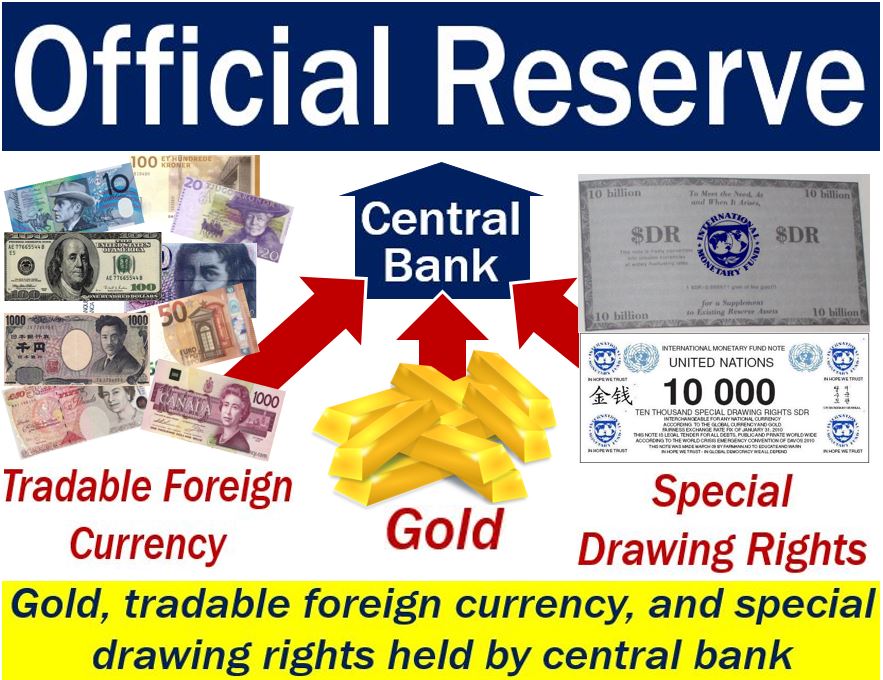Official reserve – definition and meaning
The official reserve is a country’s holdings of gold reserves, special drawing rights, and tradable foreign currency. ‘Reserve account,’ ‘officials reserves‘ (plural), ‘official reserve assets,’ and ‘international reserves‘ mean the same as ‘official reserve.’
A tradable foreign currency is one we can purchase directly or legally outside the country that issues that currency. For example, the euro, US dollar, and pound sterling are tradable currencies. In other words, you can buy and sell them outside the eurozone, US, or UK.
The Malaysian ringgit has been non-tradable since 1998, i.e., you can only buy it in Malaysia.
Official reserves of the world’s 15 largest economies
Official reserve – central banks
A country’s central bank usually holds that nation’s official reserves. The Federal Reserve (Fed) and Bank of England are the central banks of the US and UK respectively.
Central banks use their official reserves to balance their payments from year to year. When there is a trade surplus, for example, the official reserve increases. However, it shrinks when there is a trade deficit.

Official reserve – exchange rates
Sometimes, central banks use their official reserves to intervene in the foreign exchange market. If the dollar is too strong, for example, the Fed might sell dollars to bring down its value.
If a currency is too weak, the central bank will purchase its own currency. This increases demand for that currency, which subsequently raises its value compared to others.
However, exchange rate interventions are only temporary fixes. Market forces are continually influencing exchange rates. Therefore, the market equilibrium will soon resume after the central bank’s intervention.
Since the beginning of this century, the official reserve assets of the United States have fluctuated. In 2000, they stood at $128.4 billion. They reached a peak of $527.37 billion in 2012 and then dropped to $407.22 in 2016.
According to the Bank of England:
“The UK’s official holdings of international reserves comprise gold, foreign currency assets, IMF Special Drawing Rights, and the UK’s Reserve Tranche Position at the IMF.”
The special drawing rights (SDR) were created by the IMF. SDR is an international reserve asset to supplement a country’s reserve assets.
The Statistical Data Warehouse of the European Central Bank says:
“SDR holdings represent unconditional rights to obtain foreign exchange or other reserve assets from other IMF members. SDRs are not claims on the IMF. Rather, the membership of the SDR Department of the IMF incurs the asset or liability position.”
China has the world’s largest foreign exchange reserves, followed by Japan, Switzerland, and Saudi Arabia.
In August 2017, China had $3.091 trillion in foreign exchange reserves. In September 2017, the United States had $123.377 billion, while the UK’s had $179.192 billion.
Official reserves of the worlds 30 largest economies
- China: $3,115,000 million (as of October 7, 2023)
- Japan: $1,237,248 million (as of September 30, 2023)
- Switzerland: $876,985 million (as of August 31, 2023)
- India: $583,500 million (as of October 20, 2023)
- Russia: $573,200 million (as of October 20, 2023)
- Taiwan: $564,010 million (as of September 31, 2023)
- Saudi Arabia: $427,048 million (as of August 2023)
- Hong Kong: $418,365 million (as of August 31, 2023)
- South Korea: $418,301 million (as of August 2023)
- Brazil: $344,177 million (as of August 2023)
- Singapore: $337,252 million (as of August 31, 2023)
- Germany: $309,047 million (as of August 2023)
- United States: $240,324 million (as of September 22, 2023)
- France: $238,277 million (as of October 2022)
- Italy: $234,034 million (as of June 2023)
- Thailand: $221,374 million (as of July 21, 2023)
- Mexico: $204,130 million (as of July 2023)
- Israel: $202,865 million (as of August 2023)
- United Kingdom: $182,790 million (as of November 2022)
- Poland: $180,700 million (as of June 2023)
- United Arab Emirates: $151,600 million (as of June 2023)
- Czech Republic: $142,989 million (as of July 2023)
- Indonesia: $134,856 million (as of September 2023)
- Turkey: $116,647 million (as of August 2023)
- Iraq: $115,000 million (as of February 2023)
- Malaysia: $112,900 million (as of July 31, 2023)
- Canada: $106,462 million (as of November 2022)
- Philippines: $99,567 million (as of August 2023)
- Vietnam: $92,101 million (as of August 2022)
- Spain: $87,229 million (as of June 30, 2022)
For much of this century (since 2006), China’s official reservers have been the largest in the world.
In other languages
Below is a list of the term ‘Official Reserves’ in some other languages:
- Réserves Officielles (French)
- Reservas Oficiales (Spanish)
- Offizielle Reserven (German)
- Rezerwy Oficjalne (Polish)
- Riserve Ufficiali (Italian)
- Officiella Reserver (Swedish)
- Rezerve Oficiale (Romanian)
- Officiële Reserves (Dutch)
- आधिकारिक रिजर्व्स (Hindi)
- 官方储备 (Chinese – Mandarin)
- 官方儲備 (Chinese – Cantonese)
- Oficjalne rezerwy (Polish)
- Резерви Официални (Bulgarian)
- الاحتياطيات الرسمية (Arabic)
- Reservas Oficiais (Portuguese)
- Oficiální rezervy (Czech)
- 官方儲備 (Japanese)
- 공식적 예비금 (Korean)
- Официјални резерви (Macedonian)
- Oficiální rezervy (Czech)
- การสำรองเงินสดทางการ (Thai)
- ਆਫ਼ਸ਼ਲ ਰੱਖਿਆ (Punjabi)
- அதிகாரப்பூர்வ சம்பம் (Tamil)
- Առանձնատուներ (Armenian)
- ספריות רשמיות (Hebrew)
- आधिकारिक रिजर्व्स (Marathi)
- राजपत्र रिजर्व्ह्स (Nepali)
- Официјални резерви (Serbian)
- Επίσημες Αποθέματα (Greek)
Video – Official Reserves
This video, from Marketing Business Network, our sister channel in YouTube, explains the meaning of Official Reserves using simple and easy-to-understand language and examples.

